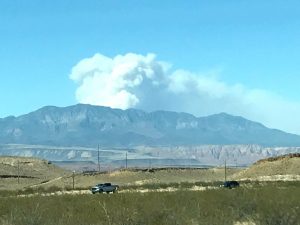 The work of PhD student Audrey Odwuor aims to leverage the elemental and isotopic composition, specifically the radiocarbon signatures, of atmospheric aerosol to contribute to better understand fire activity on land. For an ongoing project in collaboration with researchers at NASA Langley Research Center, she is analyzing aerosol sampled by the NASA DC-8 aircraft and NASA Langley Mobile Laboratory as part of the 2019 NASA/NOAA FIREX-AQ campaign, which observed wildfires and agricultural fires in the western U.S.
The work of PhD student Audrey Odwuor aims to leverage the elemental and isotopic composition, specifically the radiocarbon signatures, of atmospheric aerosol to contribute to better understand fire activity on land. For an ongoing project in collaboration with researchers at NASA Langley Research Center, she is analyzing aerosol sampled by the NASA DC-8 aircraft and NASA Langley Mobile Laboratory as part of the 2019 NASA/NOAA FIREX-AQ campaign, which observed wildfires and agricultural fires in the western U.S.
By measuring total carbon content, radiocarbon content, and stable carbon content of the aerosol samples, she can approximate the age and type of vegetation (e.g., trees, grasses) that burned in the observed fire. Combined with satellite data and satellite-derived data products on fire activity and land cover, she hopes to use the radiocarbon signatures of aerosol to contribute to a comprehensive understanding of fire activity for FIREX-AQ, namely by providing more information on fuels and fuel consumption.
She is also working on a project in collaboration with researchers at the Amazon Tall Tower Observatory in the Brazilian Amazon to use the elemental and isotopic composition of aerosol to help inform the apportionment of fire activity into deforestation versus savanna and agricultural burning. She has conducted preliminary analyses on aerosol samples from the tower in preparation for a field trip to the Amazon during which she will deploy a sampler at the tower to collect long-term aerosol samples for analysis at UC Irvine. She will also use a mobile sampler to collect aerosol at actively burned sites in the Amazon basin. The Amazon Tall Tower Observatory provides a unique opportunity to make novel radiocarbon measurements of Amazonian aerosol, and the methods developed in our lab will allow us to use these measurements to help constrain deforestation estimates.